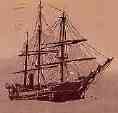|
Read Comments |
|
Add Comment |
|
Support the Museum of Hoaxes BUY MY BOOK |
|
Back to Gallery: 1869-1913 |

Frederick A. Cook

Cook's arctic steamer, the Bradley
First to the North Pole
At the beginning of the twentieth century the North Pole beckoned as a challenge to explorers. Reaching the Pole was viewed as a measure of man's highest abilities, just as reaching the moon provided a similar challenge during the 1960s. But when Robert E. Peary and Frederick A. Cook both announced almost simultaneously, and independently, in 1909 that they had reached the Pole, it was the start of decades of bitter fighting and charges of fraud, rather than a moment of glory.
Peary claimed that he arrived at the Pole on April 6, 1909. By September he had made it back to civilization and was able to telegraph the proud announcement of his achievement to the newspapers. To his astonishment he learned that Cook had already laid claim to that victory just five days previously. Cook claimed to have reached the Pole on April 21, 1908, almost a year before Peary. Cook's explanation for his delay in announcing this achievement was that he had been lost in the Arctic wilderness for over a year.
Peary immediately launched into a campaign to discredit Cook. When Cook fired back, a heated, ugly dispute ensued. With the backing of the National Geographic Society, Peary succeeded in undermining Cook's claim, and he was generally credited with being the first to the Pole. Cook's problem was that his character was repeatedly called into doubt. Evidence indicated that he had lied about earlier achievements, and in 1925 he was thrown in jail for mail fraud. Therefore, people were unwilling to trust him.
But over the years Peary's claim to the title has also come under withering assault, since he provided only weak documentation to back up his claim. It now seems possible that neither man reached the Pole (though each still has numerous supporters eager to argue otherwise). If this is the case, the joint deception would certainly rank as one of the greatest exploration hoaxes of all time.
|
Read Comments |